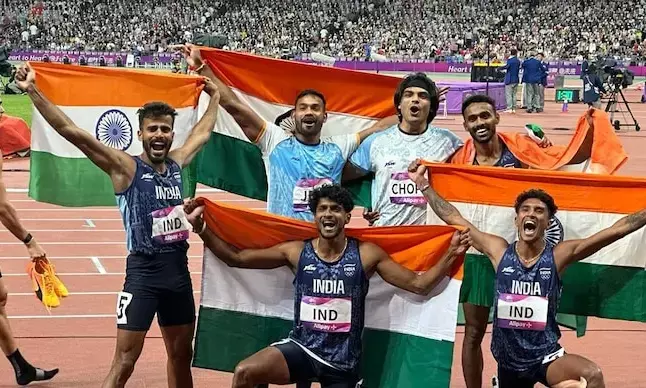We Should Build Upon The Hangzhou Success Story
India is now among the Asian sporting powerhouses

With India’s sporting fortunes on the upswing of late there were always realistic hopes that the large Indian contingent would surpass the record haul of 70 medals won at the last Asian Games at Jakarta in 2018. But in finishing with 107 medals at Hangzhou, the country’s sportsmen and women did India proud surpassing the expectations of even the most optimistic supporter.
The latest performance at the 19th Asian Games in the Chinese city underscores two very important points. India is now among the Asian sporting powerhouses and one can be reasonably sure that India will better their previous mark of seven medals at the Olympics next year at Paris,
When the Indian Olympic Association and the Sports Ministry coined the slogan “Ab ki baar, sau paar (this time, cross the 100 mark)” for the Asian Games there were few serious takers for it. After all that meant 30 more medals than last time.
Seasoned observers gave a conservative estimate of somewhere in the 80s and that was the general view. Indeed even halfway through the two-week competition at Hangzhou the 100-mark seemed far-fetched. And yet a strong surge in the last few days saw the Indian contingent go past the three-figure mark.
It will take a long time before the euphoria gets over and why not? After all this is not just a meteoric achievement but one that has developed in recent years through a systematic approach giving rise to the distinct feeling that Hangzhou could well herald a new and highly successful era in Indian sport.
For many years Indian sport has languished in the international arena thanks to the absence of a system, outdated infrastructure and a shoe string sports budget. All that is now a thing of the past.
Finally, there is a system in place that nurtures world beaters. For starters the Central government over the years has certainly done more than its bit by not only rewarding the champions with generous cash awards but also by increasing the sports budget almost every year.
Also government authorities have done well to get out of the way and allow the top sportsmen and women to train the way they want and with whom they want. Programmes like Khelo India and Target Olympic Podium Scheme have gone a long way in not just nurturing talent but also seeing to it that their progress is maintained thanks to coaching abroad and being monitored by those who are aware of international training methods.
There is also a model in place that identifies and matches talented athletes with improved infrastructure. This is facilitated by private companies like the JSW Foundation that scout athletes, make international connections and cover funding gaps for training. There is also Olympic Gold Quest founded by Geeth Sethi and Prakash Padukone which strives to complement the efforts of the Central government and various sports federations in identifying and funding the most deserving medal prospects for the Olympic Games.
There is little doubt that someone like Neeraj Chopra is a result of this system, for he has trained with leading coaches Uwe Hohn and Klaus Bartonietz.
But this is also true of other sports. At Hangzhou it was not the sports in which India is traditionally strong that brought medals like archery, wrestling, boxing, shooting and athletics; they were victorious right down the line. Medals were obtained in no less than 22 disciplines.
Again men and women did almost equally well, winning 52 and 46 medals respectively while nine were won in mixed/open events. What was even more heartening was the fact that in several events Indians got the better of traditional stronger opponents. Symbolising this was the surprise bronze medal won by the women’s table tennis duo of Sutirtha Mukherjee and Ayhika Mukherjee who shocked the world champion Chinese pair in the semifinals.
There were heroes and heroines down the line. Leading the way were shooters Esha Singh and Aishwary Tomar who won four medals each, matched by the feats of archers Jyoti Surekha and Ojas Deotale who won three golds each.
India’s final tally of 28 gold, 38 silver and 41 bronze not only augurs well for Paris next year but also for Nagoya, Japan the venue of the next Asiad in 2026. Of course they will now have a greater reputation to live up to having finished fourth in the medals table next only to China, Korea and Japan. But such is the mood right now, and so solid is their standing that there is every reason to believe that India will at least retain that position and will not falter three years hence.
But the immediate focus now is the Olympics next year. And so buoyed has she been by the record haul at Hangzhou that IOA president P.T. Usha is already talking about a double digit medals tally at Paris. That would really be something, for India’s best is seven, notched up last time in Tokyo three years ago. It improved upon the six the Indians won at London in 2012.
“The Centre is doing everything possible for the betterment of Indian sportsmen and women,’’ Usha said, adding that she supports the government’s plan for India to host the Olympics in 2036. That is too far ahead to plan.
At the moment what is imperative is to see that the gains at Hangzhou are not squandered. We should build upon this foundation which at the moment is quite firm, strong and solid. Indian sport has a momentum going and everyone associated with it should see to it that this gains steam over the years.



